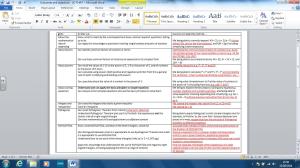“But there’s no release, no peace
I toss and turn without cease
Like a curse, open my eyes and rise like yeast”
Insomnia, Faithless, 1995
This is one of the all time classic dance tracks (indeed, it is my favourite dance track of the 1990s) and it has been quite prevalent in my mind recently. Because for the past five or six weeks, I have been suffering regular sleep loss. This blog is hopefully part of the process of dealing with the issues that have caused my depleted sleep.
I was always adamant that I would never change jobs in the middle of a school year. In 2010, however, I moved at May half term, and spent the last 6/7 weeks of the year at my new school, settling in with no real teaching timetable (in reality, I DID teach a few lessons, to a greater degree as the half term went on, but it wasn’t really full-time teaching). It was pretty easy for me.
After missing out on a couple of TLRs, I had decided this would be my last school year at my current school. However, a chance browsing of the TES jobs site one day caught my eye. A job was advertised at one of the fastest improving schools in Leeds. They held an open day which I attended with my wife (just as she had done 5 years earlier before I got my current job). We heard the executive headteacher speak. He was deeply impressive in his vision and his convictions. He spoke of mindset and a rigid positive discipline system. To put it into context, he was so impressive even my wife said she wouldn’t mind working in one of his schools – and she can’t stand children!
So I applied, I heard back, I went for interview. The school was fantastic – not a new building, but one full of impressive displays, full of incredibly polite and attentive students. I could even have my own room! My lesson went pretty well, and I felt I nailed the interview. Hours later, the call came. I had been successful!
This was the Wednesday before half term. Since then, my head has been racing in my quieter times, including, clearly, last thing at night. I am racked with excitement, nervousness, and self doubt. I went for my day at my new school on Thursday and, although I know my timetable, I am still waiting for confirmation of topics to teach. And so my insomnia persists.
Let me make it clear: this is not a criticism of my new employers. I know what is expected of me in terms of end of the year grades. When I do receive the confirmation I am after, I shall be ready. Ready to begin intensively planning for this new and exciting chapter in my career. I chapter I WANTED to embark upon.
It’s just…..there seems so much to think about now:
- what posters do I display?
- what messages do I want to convey in my first week?
- how can I help the students in making the transition from one member of staff to me as seamless as possible?
- what happens if I go in too harshly?
- and finally….what if I fail?
So now I have shared my worries, a) I hope I shall begin to sleep better, but b) I need your help. Those of you who have moved jobs mid-year – how did you cope? What advice would you share? Can you confirm that I will indeed be absolutely fine?
Please???





